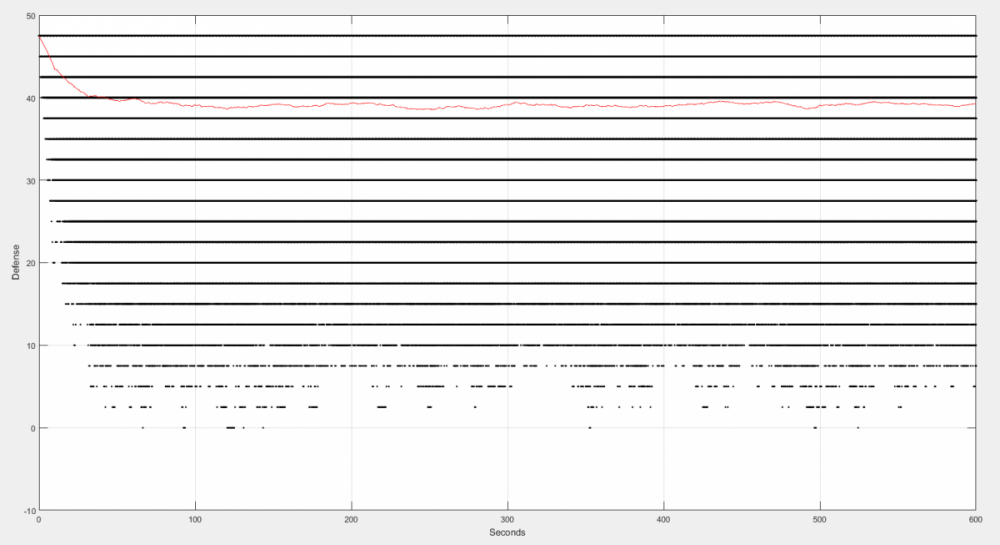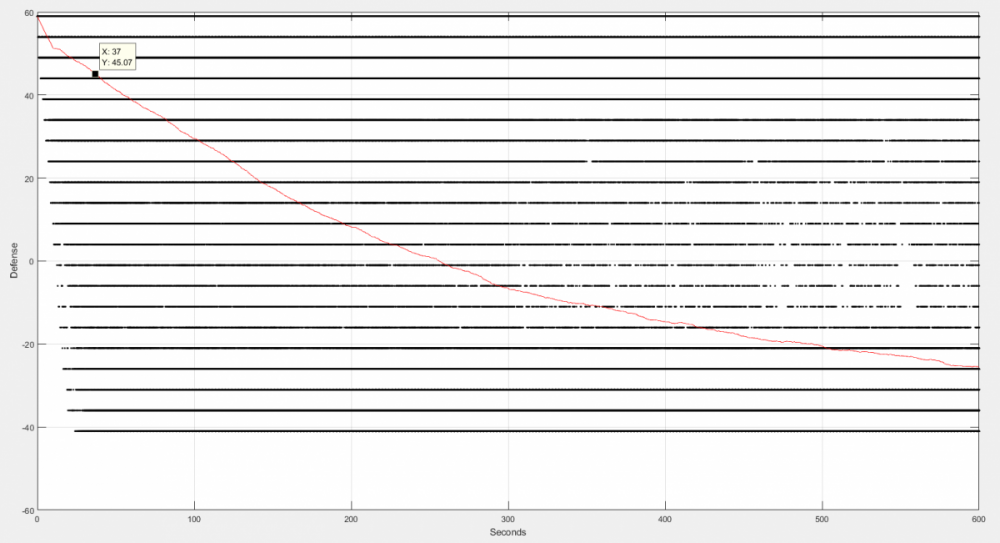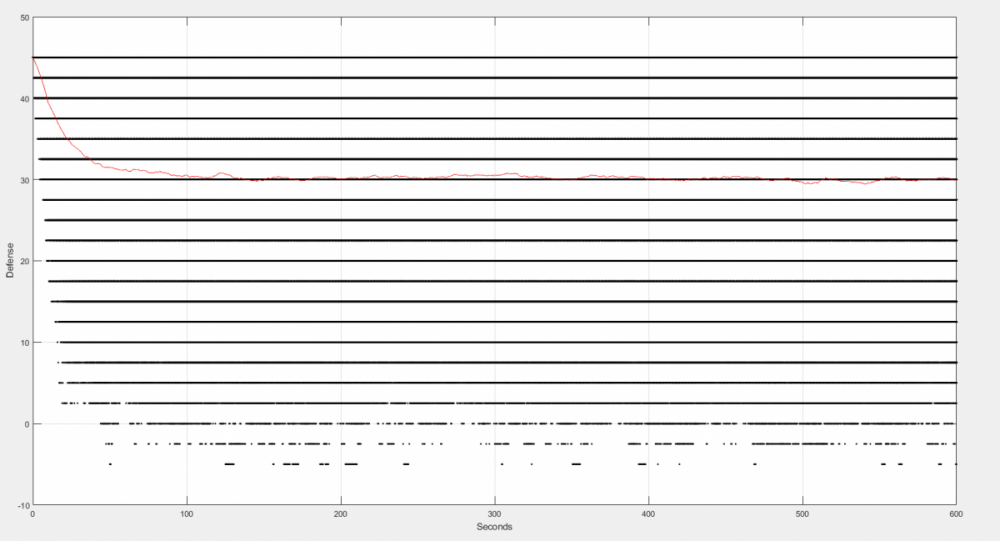The Beta Account Center is temporarily unavailable
×
-
Posts
3843 -
Joined
-
Last visited
-
Days Won
7
Content Type
Profiles
Forums
Events
Store
Articles
Patch Notes
Everything posted by Bopper
-
The chance to proc will be every 10 seconds. I haven't tested it on an Invul Tanker, but I am guessing the chance to proc will happen against every enemy in your aura at the time of a proc roll.
-
Since I had the tool open still, I figured I do one more plot. Same scenario, but having 47.5% defense with 50% DDR. This would allow you to carry one debuff while remaining at softcap. Again, 5% to-hit debuff for 10s duration using a mob of +3 LTs averaging 2 attacks per second. Notice how big of a different that extra 2.5% defense provided in this scenario, averaging out to about 38% defense over time.
-
It depends on how strong the debuffs are and what your defense was originally set at. But with 95% DDR and a nice cushion of defense, most likely you won't succumb to defense debuffs. More likely To-Hit buffs or lucky RNG. There is an arc in DA, I think it's Part 3 (Face of the PPD). Lots of defense debuffs in that mission. A good test for seeing how you handle debuffs. I want to say 7.5% for 10s, but there are lots of attacks and its hard to follow each
-
absolutely. I never revisited the math after building my simulator, but if I were to derive a formula it would certainly be a function of number of attacks per second, amount of debuff per attack, and the duration window of the debuff. My guess is, I will take the average number of attacks in a window and calculate from there, but let's be honest, we're talking about deriving random processes...and I barely still remember how to solve random vectors. Throw time into it and my brain wants to shut off.
-
A few things here. You are forgetting to factor in accuracy modifiers for rank and level. Unless you're only fighting same-level minions, then you're right to assume they have a 5% probability to hit you. Otherwise, it will be higher. The correct analysis to do is figure out what is the average number of attacks per second you are facing, factor in the amount and duration of a defense debuff, then evaluate the probability of being hit enough times within that duration to eventually cause the probability of hitting you to increase (when defense becomes less than 45%). At that point, you need to determine if you will proceed to hit cascading failure or if you will simply live on the edge of that 45% defense (it's possible debuffs end right before you get hit with another that would cause you to fail). Luckily, we don't HAVE to do all that math. I built a program last year (ok, a script technically) that will take your starting defense, your DDR, the average number of attacks per second you face, the amount of defense debuff in the attack, the duration of the debuff, and I run over a thousand simulations in seconds to plot out the performance, drawing a pretty red line that shows your average performance over time. For example, let's assume you are facing a +3 mob of LTs (instead of averaging out minions and bosses, i'll just use the LT accuracy modifier of 15%). Let's assume the incoming attacks are 2 per second and the debuff amount is 5% and the duration of a debuff is 10s. What would your performance look like if you have 59% defense and no DDR and the enemy has base 50% To-Hit? Good news, in this scenario, you can go "on average" 37 seconds before your defense dips below 45%. That is very good, it means you will likely have moved on from those enemies before that point would occur. However, it's not all roses. Those black lines you see on the graph are actual results from simulations and you can see you will on occasion reach cascading failure very quickly if you get unlucky with RNG. For what it's worth, same scenario for 45% with 50% DDR. Here, very interesting results. On one hand, it goes into sub 45% defense immediately (no surprise there) but on average the cascading failure doesn't happen. It actually levels off around 30% defense. Sure, it can proceed to cascade failures too by evidence of the simulations that dropped to 10% and below, but over the long run it did hold up somewhat ok. Hope that helps. Don't take the two plots as definitive evidence, it is merely a data point for a single set of parameters and is not all-encompassing of what you have in game.
- 361 replies
-
- 11
-

-

-
When I say damage debuff, it means their damage output of that type is debuffed. HOWEVER, the enemy can resist your damage debuffs using their damage resistance. Let's use your example to illustrate what I mean. Let's say you apply a 40% damage debuff on the target, and the target has 30% resistance to smashing and 0% resistance to everything else. The final damage debuffs would be: The enemy's smashing damage will be debuffed by 28% (40% * (1 - 30%)) All other damage from the enemy will be debuffed by 40% (40% * (1-0%)) Now let's say you apply a 20% resistance debuff on this enemy. Now the final damage debuffs would be: The enemy's smashing damage will be debuffed by 33.6% NewResDebuff = (20% * (100% - 30%)) = 14% NewRes = (30% - 14%) = 16% NewDMGDebuff = 40% * (100% - 16%) = 33.6% All other damage from the enemy will be debuffed by 48% NewResDebuff = 20% NewRes = 0% - 20% = -20% NewDMGDebuff = 40% * (100% + 20%) = 48% Breaking it up line by line can be cumbersome, so I use the formulas from my original post: NewDebuff = Debuff x (100% + ResDebuff) x (100% - EnemyResist) NewDebuff = 40% x (100+20%) x (100%-30%) = 40*1.2*0.7 = 33.6%
-
Did you try maximizing graphics and reattempt? Edit: Nice snipe
-
The regwnwration works like this (basically). You get 5% regeneration always, them you gain 1% of regeneration for every 1% of health you lose. So at most it would give 105%...when you die. Recovery is opposite. You start with 36% recovery, then lose 0.36% recovery for every 1% of health you lose.
-
Typically, high base damage ATs (such as stalker) would benefit more from Core. However, if you ever want an exact answer, I have a tool that allows you to put in your numbers to see which Assault Hybrid option would work better for a particular power. One thing you can always be rest assured on, Assault Radial will not be limited by the damage cap. But if you mainly solo or not in teams that buff your damage excessively, Core likely will win out for you.
-
You can use Steam Jump (or Jump Pack, its equivalent) one of two ways. You can use it as a jump power that symply increases your maximum jump height but does not increase your jump speed, and it has the added bonus that you can control your elevation by falling and rising on your command. The other way to use it is when you are flying, which includes hover, fly, jet pack, etc. The strength to fly speed from Steam Jump (and Jump Pack) will max out your speed for those powers. So if you want to use Hover with Steam Jump, you can go as fast as Fly (assuming no afterburner). Check out the video I posted that shows the effects of using Steam Jump/Pack while flying to see what I mean. As for the rest of the stuff, you might want to post that in the Suggestions/Feedback Forum. Let the devs know that you would like more creature options for transformation travel powers and that you would like to not look like you have to take a shit while running when using Ninja Run.
-
Something different. Notice the Hero Designer would tie into Mids Reborn.
-
You got Energy Melee on the brain...I wonder why 🤔.
-
Yup, seems to have been a stealth nerf around the time of CotS and PT procs going to 1 proc only in AoEs. No mention of that change going into effect and despite multiple bug reports, no comments on the matter from the development team. It might fall under the "not working as intended" category, but still, when a change like that happens, there should be a patch note.
-
Revision History: 2020 July 25: Initial Document
-
How to Calculate Debuffs When factoring in Strength, Resistance Debuffs, and Enemy Debuff Resistance By Bopper 25 July 2020 Author’s Note The motivation for this guide comes from a tool I developed from knowledge of the mechanics presented by Trickshooter and Frosticus. Their work helped me better understand how resistance debuffs interact with debuffs (Damage debuffs interact with Damage Resistance debuffs, To-Hit debuffs interact with To-Hit Resistance debuffs, and so on) and I wanted to pass along that information with examples and highlight how you can use the tool to do your own calculations. Some quick things with the format of this guide. First, I try to use wording that we see in the game, so I use the term "unresistable" whenever referring to an effect that ignores resistances. Also, there is a lot of verbiage on debuff resistances and resistance debuffs. That will come off as confusing, but I try to use consistent language when using the terms. A Resistance Debuff refers to when you debuff an enemy's resistance to debuffs. This effect is usually denoted in game as -Res(TypeDebuff) and it essentially acts as a way to increase the effects of that type of debuff applied on that target (similar to how debuffing damage resistance increases everyone's damage, debuffing a debuff resistance will increases everyone's debuff of that type). A Debuff Resistance refers to the amount of resistance an enemy has to debuffs. The equivalent to this is your character's debuff resistances such as defense debuff resistance (DDR) or recovery resistance. Hopefully that clears it up, but if it is still too technical, just remember Resistance Debuff is good, Debuff Resistance is bad. How Debuffs are impacted by Resistance Debuffs: Trickshooter goes into excellent detail on the steps of these mechanics, but I’ll summarize the best I can. When a Debuff is applied, it has a base amount (e.g. Defender’s Radiation Infection does -31.25% To-Hit debuff and -31.25% Defense debuff). That debuff can be increased in strength from enhancements and/or strength buffing effects (like Power Boost). This serves as an effect multiplier, for instance let’s say you slot 20% enhancement to the To-Hit Debuff and you get 98.34% strength to To-Hit Debuff from Power Boost, the new To-Hit debuff would become -31.25% x (100% + 20% + 98.34%) = 68.23%. However, Strength is not the only way you can improve your debuffs. You can also apply a resistance debuff to the target. This may show in the form of something like -40% Res(ToHit). This would apply a 40% resistance debuff to the target’s to-hit debuff resistance. Is that a mouthful? That’s because this is the same “resistance resists resistible resistance debuffs” situation you typically see discussed when talking about damage resistance debuffs (which I’ll get to shortly). Let's now assume you face a Level 50 AV, which typically will have 85% resistance to all debuffs. So applying a 40% resistance debuff to their To-Hit will cause their new resistance to become: New Debuff Resistance = 85% - 40% x (100% - 85%) = 79%. Now that we have the final strength of our debuff and the final resistance of the target’s resistance to that debuff, we can calculate the final debuff applied to the target. Using the numbers in our example, we have 68.23% To-Hit debuff which the target resists 79% of, leaving the final debuff to be: Final Debuff = 68.23% x (100% - 79%) = 14.33% To-Hit debuff. There is a simple formula we can use to calculate these effects: Final Debuff = (Base Debuff) x (1 + AddedStrength) x (1 + Res[Debuff]) x (1 – DebuffResistance) In our example, that becomes: Final Debuff = 31.25% x (1 + 0.20 + 0.9834) x (1 + 0.40) x (1 – 0.85) = 14.33% There are other factors to consider, such as purple patch. This will impact the base debuff and it will impact the Resistance Debuff (Res[Debuff]) that is applied. So if you were facing a level 50 AV and you were only level 47, the +3 con of the enemy would make your effects have only 65% strength. This changes the results of the debuffs as so: Final Debuff = (Base Debuff) x (Purple Patch Modifier) x (1 + AddedStrength) x (1 + (Purple Patch Modifier) x Res[Debuff]) x (1 – DebuffResistance). In our example that would result in: Final Debuff = 31.25% x 0.65 x (1 + 0.2 + 0.9834) x (1 + 0.65 x 0.4) x (1 – 0.85) = 8.38% What about Damage Debuffs? Damage Debuffs work in conjunction with the Damage Resistance of the target. Frosticus went into extensive detail on how this interaction works in their Poison Guide, but the big take away is Damage Resistance Debuffs will improve your Damage Debuffs, and because damage resistance varies by damage type, those damage debuff effects will also vary by damage type. This doesn’t change our formula from before, just need to factor in the damage type. The main difference is damage debuffs always ignore strength so you won’t have strength improvements from enhancements nor outside buffs: Final Damage Type Debuff = (Base Damage Type Debuff) x (Purple Patch Mod) x (1 + (Purple Patch Mod) x ResistanceDebuff) x (1 - DamageTypeResistance). For an example, let’s use Defender’s Enervating Field which provides a 25% damage debuff and a 30% resistance debuff and we will assume the target is a Level 50 AV while we are Level 47. Let’s assume the AV has 40% resistance to Smashing Damage and 0% resistance to Energy Damage. Final Smashing Damage Debuff = 25% x 0.65 x (1 + 0.65 x 0.30) x (1 – 0.40) = 11.65% Final Energy Damage Debuff = 25% x 0.65 x (1 + 0.65 x 0.30) x (1 – 0) = 19.42% This means we reduced the damage of Smashing attacks by 11.65% and we reduced the damage of Energy attacks by 19.42%. Ideally, you debuff an enemy that has low resistance to the type of damage they attack with. Next, let's compare these results to a 25% Damage Debuff with no Resistance Debuff and we can see the improvement made by the Resistance Debuffs: Final Smashing Damage Debuff = 25% x 0.65 x (1 + 0) x (1 – 0.40) = 9.75% Final Energy Damage Debuff = 25% x 0.65 x (1 + 0) x (1 – 0) = 15% How to Apply this Formula for Calculating Damage Damage can be treated as its own debuff, as it debuffs their health. Ok, I might be stretching with that comparison, but the nice thing is the formula doesn’t have to change: Final Type Damage = (Base Type Damage) x (1 + AddedStrength) x (Purple Patch Mod) x (1 + (Purple Patch Mod) x ResistanceDebuff) x (1 – DamageTypeResistance) Let’s assume we’re doing an attack that does 200 Smashing Damage and we have +95% enhanced damage and +30% global damage buff. We apply a 20% resistance debuff to an enemy that is +1 (0.90 purple patch) and they have 25% resistance to smashing damage. Final Smashing Damage = 200 x (1 + 0.95 + 0.30) x 0.90 x (1 + 0.90 x 0.20) x (1 – 0.25) = 358.425 smashing damage. How to incorporate Unresistable Debuffs and Unresistable Resistance Debuffs So far, all discussion has only looked at resistible debuffs and resistible resistance debuffs. There are effects that can be unresistable which can include debuffs and resistance debuffs. This does not change the math at all, just expands the formula to breakout the resistible and unresistable portions. Final Resistance Debuff = (Purple Patch Mod) x ( UnRes[Debuff] + Res[Debuff]x (1 - DebuffResistance) ) FinalDebuffResistance = DebuffResistance - (Final Resistance Debuff) Resistible Debuff = (Base Resistible Debuff) x (1 + AddedStrength1) // I am showing AddedStrength1 and AddedStrength2 to highlight the debuffs could be from different powers and thus have different enhancements. Unresistable Debuff = (Base Unresistable Debuff) x (1 + AddedStrength2) Final Debuff = ( (Unresistable Debuff) + (Resistible Debuff) x ( 1 – (FinalDebuffResistance) ) ) x (Purple Patch Mod) This certainly looks messier, but trying to fit it all into one formula might be a bit much to take in. So I hope breaking it out like this helps make sense of the steps used to calculate the Final Debuff amount. Luckily, unresistable debuffs and unresistable resistance debuffs are rare and hopefully you won't need to calculate them too often. To help bring this home, let's assume a hypothetical power. Let's say we have a power that does 20% base to-hit debuff, however this power is unique in the fact half of that is unresistable. This would mean 10% can be resisted and the other 10% is not resisted. Let's assume the power is enhanced by 50%. The target we are debuffing has 85% resistance to to-hit debuffs and is +2 level con (80% strength purple patch). Finally, let's assume another power is used that provides a 40% resistance debuff to to-hit on the target (not enhanced, resistible). What is the final to-hit debuff on the target? Final Resistance Debuff = 0.80 x (0 + 0.40 x (1 - 0.85) ) = 4.8% FinalDebuffResistance = 85% - 4.8% = 80.2% Resistible Debuff = 10% x (1 + 0.50) = 15% Unresistable Debuff = 10% x (1 + 0.50) = 15% Final Debuff = (15% + 15% x (1 - 0.802) x 0.80 = 14.376% How to use the Resist/Debuff Calculator To calculate all of the final Damage Debuffs use the first calculator in the Resist/Debuff Calculator sheet of Bopper's CoH Tools and Formulas. You can input the total amount of resistance debuffs, unresistable resistance debuffs (rare), damage debuffs, and unresistable damage debuffs. Next, select the Enemy Con level from the drop-down list and you input each of the different Damage Type Resistances the target has. Using our example of the +3 Level 50 AV and our Defender with Enervating Field we can see we get the same results by providing those parameters: To calculate non-damage debuffs, you might find the bottom two calculators more useful. There is no functional difference between these two calculators, there are multiples simply for Quality of Life (QoL) purposes. You might want to look at two different debuffs side by side, so having two calculators can do that for you. Also for QoL purposes, you can compare up to 4 different targets in each calculator. You can change the purple patch effect and the debuff resistance for each of the 4 targets. Below, I plugged in numbers from a couple of the examples used in this guide: In the top calculator I plugged in the numbers from the numbers of the Radiation Infection example. The 68.23125% To-Hit Debuff (after enhancement and power boost) is entered into the Debuff field. A hypothetical 40% Res(To-Hit) debuff was entered into the Resistance field. There were no Unresistable debuffs in this example. The final debuff was then calculated for 4 targets: Even Con enemy with no debuff resistance, an even con Level 50 AV with 85% to-hit debuff resistance, a +3 Level 50 AV with 85% to-hit debuff resistance, and a +4 Level 50 AV with 87% to-hit debuff resistance. The PP column represents the purple patch modifier, and its values are manually entered along with the resistances of the targets. The output breaks down the Final Resistance Debuff applied to each target, what the new Debuff Resistance becomes, and what the Final Debuff will be. We can see for the Even Con AV, the debuff was 14.33% and the +3 AV was 8.38%, just like in the examples above. The bottom calculator performed the hypothetical unresistable debuff example. A 40% Res(To-Hit) was applied, as well at a 15% resistible To-Hit Debuff (after enhancement) and 15% unresistable To-Hit Debuff (after enhancement) were plugged into their respective fields. Compared to the +2 Level 50 AV with 85% to-hit debuff resistance, we see the final resistance debuff, new debuff resistance, and final debuff all match the results provided in the above example.
-
True. Bio with its damage aura, resistance debuff, damage buff, amd regeneration debuff it pulls well ahead of all armor sets in terms of damage performance. Radiation is also strong with its regeneration debuff that can be proc'd out as a significant damage dealer. Meltdown gives a 60s damage buff and although the set does not have a damage aura, it does have a defense debuff toggle that can take the Achilles Heel resistance debuff proc and is a recharge booster. It helps both sets also throw tons of recovery and regeneration and absorb to give you tons of fuel and survivability.
-
(reserved)
-
Revision History: 2020 Jul 24: Initial Document 2020 Aug 1: Minor updates to some of the tools Corrected Formatting on Cancel-On-Miss to better handle 100% probability to tick. Also extended max ticks from 30 to 75. Corrected a bug in Recharge Calculator that would result in a broken formula if there are no Temporary Buffs. Should be working now. 2020 Aug 3: Added chart to Proc Probability Calculator (PPM) to show damage for Regular and Epic Damage Procs from levels 1-50. 2020 Aug 8: Added new calculator to PPM. The Proc or DMG Enhancement calculator will calculate the equivalent amount of added damage a proc provides to help you determine if it's more optimal to slot the proc or to slot a damage enhancement. Thanks @Replacement for the addition. 2020 Sep 1: Various Bug Fixes Corrected the Resistance/Debuff Calculator to properly calculate Final Resistance when Unresistable Resistance Debuffs are applied. Thank you @Elmyder for bringing this to my attention. Corrected the Survivability Tool and HP/Regeneration Proc Cheat Sheet to properly reflect the fact Arachnos have a base regeneration of 10 seconds as opposed to 12 seconds. Thank you @macskull, @Gulbasaurand @Vandenfor your assistance with this. 2020 Sep 5: Added two new fields to the Proc Probability Calculator (PPM) (Input) Desired Proc Probability - User inputs the amount they want their Proc to perform at (typically this is 90%, the max) (Output) Desired Allowed Recharge - The amount of recharge to slot to achieve the Desired Proc Probability. 2020 Dec 13: Updated the Survivability Tool to v3.0 Added Mastermind's Bodyguard Mode to reflect spreading damage across pets. Incorporated Purple Patch to modify the strength of enemy damage, to-hit debuffs, and damage debuffs. Previously, it was assumed the numbers entered in the spreadsheet to be post-purple patch. Now it is pre-purple patch.
-
Bopper's CoH Tools and Formulas Over the past year I have written numerous guides and I have read numerous guides. And from those guides I developed tools that I use to do calculations fairly quickly. One of my tools I shared previously (The Survivability Tool), but I decided to share the rest of them in a single Google Sheets document. So, over the past month I ported them into a Google Spreadsheet and I think it’s cleaned up enough to share with the community. Most of these tools are from guides I posted, but a handful of them are tools created from information learned by others. Links to these guides will be embedded below. The contents of the Bopper's CoH Tools and Formulas spreadsheets include: Proc Probability Calculator Recharge Calculator Pylon DPS/Time Calculator Assault Hybrid Comparator Cancel-On-Miss DoT Calculator Resistance/Debuff Calculator Survivability Tool Design Formulas HP/Regeneration Proc Cheat Sheet
- 20 replies
-
- 19
-

-

-

-
Nerf Incarnates! Haha. I do more thanks to Ageless than I could every get out of Rage.









